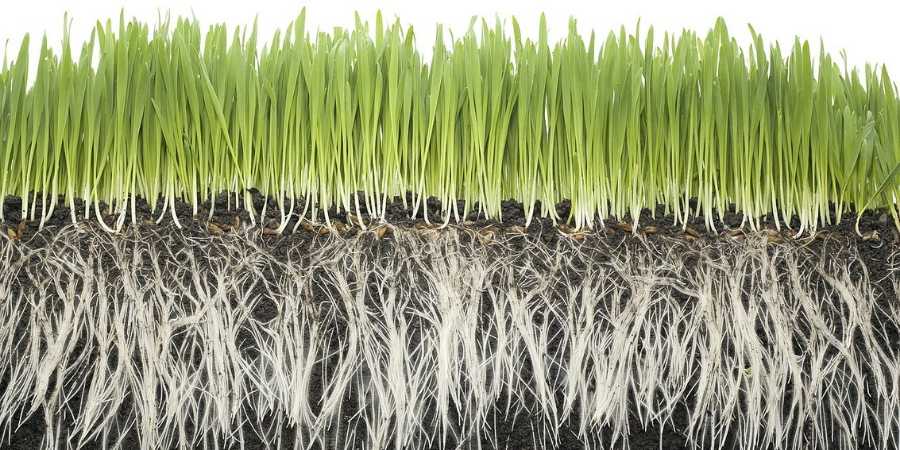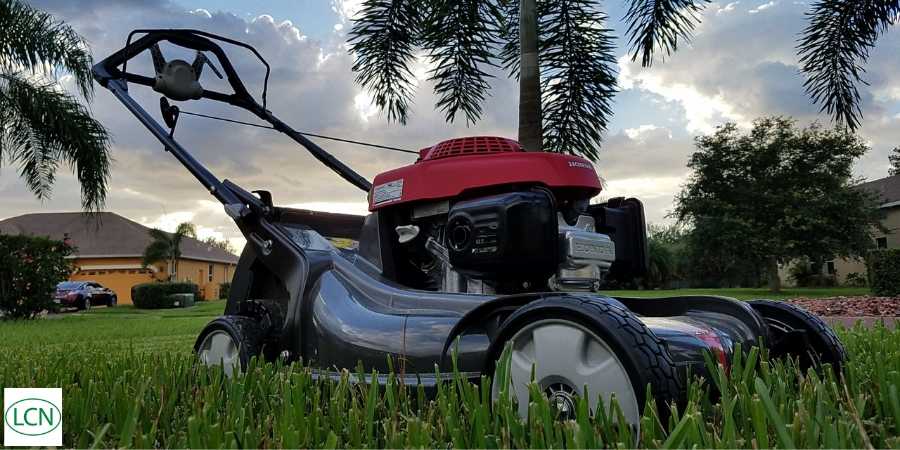How to Grow Deep Grass Roots
- "The Lawn Care Nut"March 23, 2019
The key to a healthy lawn is healthy soil, and the link between your turf and that soil are roots. Deep, dense roots. If you have them, chances are your lawn shows it too. But how can you get more, deeper roots? It’s easy and you can start right now, plus enjoy some of your own physical benefits to boot.

The More You Mow
I often say, “The more you mow, the healthier your lawn will grow.”
That’s because mowing stimulates the turf to spread roots, and in some grass types, rhizomes and stolons too.
I know you may have had struggles with your lawn in the past so trust me when I tell you that your grass; it definitely wants to grow and be healthy. All of us know that grass will weave through cracks in your sidewalk in order take a foothold. It ends up in your flower beds too and it grows wild on the side of the roads and highways of America. It’s quite adaptable and surely relentless.
Because of this, you can literally “shape” its growth habits by mechanical means, ie: mowing. Let me paint the picture here for you:
After the shortened, overcast days of winter, when the lawn wakes up - its first instinct is to grab sunlight. This is where the process of photosynthesis comes into play. The turf has literally been sleeping all winter and now that spring rains are nourishing and waking up the soil, it’s a mad dash to prepare for the coming long summer! That’s why your grass is trying to grow tall towards the sun in spring, opening up long, fat grass blades that grab sunlight like solar panels.
If you have cool-season turf like bluegrass or fescue, it’s got a short window of time in spring to get ready for summer stress (another possible dormancy period) whereas with warm-season turf types like Zoysia, Bermuda, St Augustine and Centipede, yours ramps up slowly and enjoys it’s peak growing season in the dead of summer. But both need energy from photosynthesis to get there!
Make Your Turf Angry
As your turf is looking to reach for the sun, the act of mowing will, in a sense, anger it! But it doesn’t stay angry, instead, it adapts.
You have to realize, its mission is to get thick and take over land, crowding out competition from weeds. It grows tall, wide and deep in order to do this.
If you take away one of its strategies, in this case, vertical growth, it’s just going to adapt and put much more energy into its other two modes of land takeover and those are roots (deep) and stolons/rhizomes (wide).
It’s similar to the same response your body makes when you work out. You know that sore feeling in your muscles after your first weight lifting session for your New Year’s resolution - you know how it hurts really bad for a few days after?
But if you keep up that weight lifting or tearing down of the muscle, what does it do?
It grows wider and thicker so it can better resist the stress you are putting on it from the weights themselves and you, as a human become more fit overall. If you never stress your muscles, they don’t have to grow thick to live, but when you stress them or tear them down, they rebuild stronger.

Turf does this too in its own way. If you keep cutting it down, in response it will grow wider and deeper to compensate with more roots. This larger root mass can then support more grass blades on top. You are cutting frequently, so those more numerous grass blades will be shorter.
More grass blades that are short can grab, in theory, the same amount of sun that fewer, longer grass blades can… however, the more abundant shorter blades end up being a much thicker, more appealing lawn overall and thus you have used mowing to dictate the thickening of the turf.
Cool right?
How Much Mowing For Thicker Roots?
I recommend you get out and try mowing 2x per week to start. I call this #WeekNightLawnWork and have been encouraging folks to mow every weekend like they normally do, but add in a second mowing on Wednesday night. This “doubling down” on your mowing will accomplish our goal of more roots and a thicker lawn quite quickly. It will also help you get in shape because midweek mowing is great exercise!
For grass types like Kentucky Bluegrass in the north, and Zoysia, St Augustine, Centipede and Bermuda in the south, this practice can yield visible results in just 90 days, especially if you are pushing healthy nutrients with Milorganite.
The more you mow, the healthier and thicker it will grow!

Lawn Mowing Heights for Deep Grass Roots
Whether you realize it or not, committing to this double-up on the mowing is going to help you follow one of the primary rules in lawn maintenance, and that is, the “1/3rd Rule.”
This rule states that you should not be removing more than ⅓ of the grass blades’ length in a single mowing. This way you are not stressing the turf. If you are mowing twice per week, I’m willing to bet you’ll be good on this one!
But there is one other consideration and that is mowing height. Each grass type has mowing heights that assist it in optimal growth and this is another way to help it get thicker, quicker. Below are my suggested mowing heights for each grass type:
Cool-Season Grass Types
| Kentucky Bluegrass | 3.5”+ |
| Perennial Ryegrass | 3.5”+ |
| Fine Fescue | 3” |
| Turf Type Tall Fescue | 4”+ |
Most of you will have mixes of these grass types so when in doubt, take that mower all the way to the highest setting and leave it there. Done!
Warm-Season Grass Types
| St Augstinegrass | 3.5” + |
| Centipedegrass | 3” + |
| Bermudagrass | 1-2” (consider going lower with a reel mower!) |
| Zoysiagrass | 1-2” (closer to 1” is better, also could consider reel mower!) |
| Bahia | 4”+ |
Enjoy The Mow my friends!

